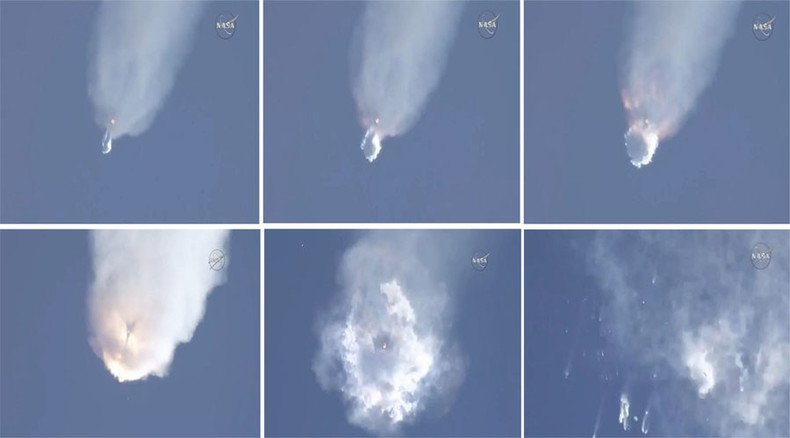‘Pretty crazy failure’: SpaceX rocket blast blamed on weak steel strut

The “most probable” cause behind the blast that destroyed the unmanned Dragon cargo spacecraft on takeoff last month was a flawed steel strut, the investigation has found, announcing that SpaceX missions will not resume until at least September.
The space company’s founder and chief executive Elon Musk told reporters that the June 28 faulty launch was most likely caused by a failure of one of the 2-foot (61 cm) steel struts holding a helium container inside the rocket’s second stage fuel tank.
“It’s a really odd failure,” Musk said, as he noted that the struts were tested out strong in the past and were designed to handle 10,000 pounds (4,500 kg) of force. While during last month’s launch the component was exposed to only 2,000 pounds (900 kg) of force, the investigation was eventually able to replicate the fault after “taking an enormous number of these struts and testing them all.”
The broken strut was just one of many that are holding the helium pressure containers inside the liquid oxygen tanks. The investigation however believes that once the strut snapped, the container collapsed and overloaded the oxygen tank with helium, exerting too much pressure that led to explosion.
“This is the best of what we know thus far,” said Musk during a press conference. “We emphasize this is an initial assessment, and further investigation may reveal more over time.”
READ MORE: SpaceX rocket to ISS disintegrates 2 minutes after launch (VIDEO)
The material used in that particular strut was likely to blame, Musk added, not mentioning the supplier of the component. After the tests showed “a few” struts falling “well below rated level” and “several” not meeting specifications, SpaceX will now use different struts with a solid safety records. Procedures for testing the struts before lift-off will also be changed to test individual units despite the “significant” cost rise, he said.
“It's the first time we've had a failure in seven years so, to some degree, the company as a whole got a little complacent,” said Musk. “Especially with all the successes in a row, I think this is an important lesson and something we'll take with us into the future.”
Watched #Dragon launch from @space_station Sadly failed Space is hard Teams assess below @NASAKennedy#YearInSpacepic.twitter.com/myi3col5Ix
— Scott Kelly (@StationCDRKelly) June 28, 2015The Falcon 9 exploded less than 3 minutes after take-off from Florida’s Cape Canaveral Air Force Station on June 28, losing ISS destined payload comprising off 2,477 kg of food, clothes, and materials for onboard experiments.
READ MORE: Rockets in ruins: Spectacular unmanned spaceship crashes (VIDEOS)
To avoid further loss of cargo on future missions, SpaceX plans to introduce new software that will enable the Dragon capsule, in case of future disasters, to deploy a parachute. Equipping the capsule with such system would have saved the capsule’s cargo, Musk said. The CEO noted that the Dragon capsule survived the initial explosion and continued sending signals to the command center for a while after the disaster.
Musk hopes that Falcon 9 failure will not impact the company’s contract with NASA for its Commercial Crew Program, which would involve delivering astronauts to the ISS. Since the US space shuttle program was shut down in 2011, Russia’s Soyuz rocket remains the only way to deliver crews to the station and back.
As a precaution, the first test launch of SpaceX’s Falcon Heavy rocket, developed for manned missions has been postponed. Scheduled for test flight later this year, the Falcon Heavy launch is now penciled in for spring of 2016.
SpaceX has a $1.6 billion NASA deal for at least 12 unmanned deliveries to the ISS using the two-stage Falcon 9 rocket with the Dragon capsule. Prior to last month explosion, Falcon 9 has experienced only one partially failed launch in 2012, and in the past three years has delivered six cargo loads to the ISS.












